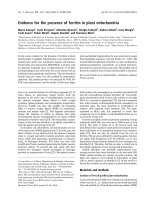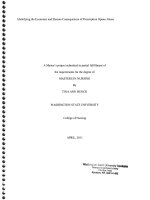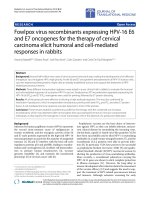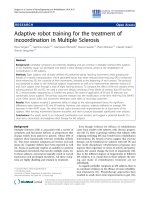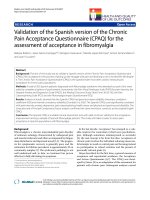Bioanalytical strategies for the quantification of xenobiotics in biological fluids and tissues 1
Bạn đang xem bản rút gọn của tài liệu. Xem và tải ngay bản đầy đủ của tài liệu tại đây (465.27 KB, 20 trang )
Chapter 1
1
Chapter 1 Introduction
Chapter 1
2
1.1 Preface to Chapter 1
A concise literature survey emphasizing the xenobiotics absorption, distribution,
metabolism and its biotransformation in the organism are dealt in this chapter in
detail, which may help to understand adverse health effects represented by these
substances. This is followed by a brief literature survey on the micro extraction and
quantification techniques and their significance in the disease diagnostics. The aim
and scope of the present study are presented at the end of this chapter.
Chapter 1
3
1.2 Xenobiotics
A xenobiotic is defined as a chemical that is not usually found at significant
concentration or expected to reside for long periods in organisms. In addition to man-
made chemicals, natural products that are present in much higher concentration than
are usual could also be of interest if they have potent biological properties, special
medicinal properties. Any compound in the environment that poses a risk of exposure
to a given organism also called xenobiotics [1]. Xenobiotic chemicals can be
classified based on their exposure medium as they enter the body via the environment,
diet and medication.
During the past 50 or so years, vast quantities of diverse synthetic chemicals
(xenobiotics) have entered the environment because of efforts to increase agricultural
productivity and because of modern industrial processes. Chemicals which are
exposed to the environment as a result of industrial effluent, fertilizers usage, natural
disaster and accidents are accumulated in the air, water and soil. Environmental
xenobiotics include chemical carcinogens, herbicides, insecticides, fungicides,
styrene, polychlorinated biphenyls, nitrosamines, aromatic hydrocarbons, biphenyls,
halogenated hydrocarbons and chemicals from building and constructing
environments such as flame retardants, plasticizers, UV-blockers and biocides [2].
The contribution from industrial point sources, for instance, incineration industries
(e.g. coal, tar, steel and gas production) are polycyclic aromatic hydrocarbons
(PAHs), polychlorinated biphenyls (PCBs) and persistent organic pollutants (POPs).
These pollutants are generally chemically stable over long periods of time. Hence,
many xenobiotics are recalcitrant and persist in the environment and increase in
Chapter 1
4
concentration with time. For example, burning of plastics and certain fertilizers forms
dioxin, a xenobiotic toxin, so pervasive and it can be found in nearly every human
being [3]. Many inorganic species may also be of particular concern if they are
recalcitrant during most processes of wastewater treatment. These may include salts
of common ions such as sodium, potassium, calcium, chloride and bromide, as well as
trace heavy metals [4, 5].
Similarly, when xenobiotic compounds such as agrochemicals and industrial
chemicals are utilized, they eventually reach the soil environment. Such chemicals in
soil are totally available to microorganisms, plant roots via direct, contact exposure;
subsequently these organisms are consumed as part of food web processes and
bioaccumulation may occur, increasing exposures to higher organisms up the food
chain [6, 7]. Persistent pesticides, chemical solvents and others tend to slowly invade
the environment, bioaccumulate in the food chain, and have long half-lives in animals
and humans [8]. Ingestion of contaminated fruits and vegetables is a potential
pathway of human exposure to xenobiotics. Fruits and vegetables may become
contaminated by several different pathways. Ambient air pollutants may be deposited
on or absorbed by plants, or dissolved in rainfall or irrigation waters that contact the
plants. Plant roots may also absorb pollutants from contaminated soil and
groundwater. The addition of pesticides, soil additives, and fertilizers may also result
in food contamination [9]. Another potential pathway of xenobiotics towards the
human body is via foods from animal origin. The major exposure route both for
humans and animals is by ingestion of endocrine disrupting chemicals (EDCs) via
food intake, which leads to bioaccumulation and bio-magnification, especially
towards species at the top level of food chain. For example, in the case of fish eating-
Chapter 1
5
birds and marine mammals, it has been found that these mammals may contain
concentrations of POPs many times higher than those found in the fish on which they
feed [9-11].
In the same way, a large number pharmaceuticals and personal care products
(PPCPs) are continuously released into the environment. Antibiotics, vitamins,
supplements, and sexual enhancement drugs are contained in this group. "Personal
care products" may include cosmetics, fragrances, menstrual care products, lotions,
shampoos, soaps, toothpastes, and sunscreen [12]. Effluents from sewage treatment
plants are well known to be the major source for introduction of PPCPs into the
aquatic system. PPCPs enter into the environment through individual human activity
and as residues from manufacturing, agribusiness, veterinary use, and hospital and
community use. Individuals may add PPCPs to the environment through waste
excretion and bathing as well as by directly disposing of unused medications to septic
tanks, sewers, or rubbish vegetables. Because PPCPs tend to dissolve relatively easily
and do not evaporate at normal temperatures, they often end up in soil and water
bodies. Illicit drugs such as methamphetamine and cocaine are another type of PPCP.
The manufacturers of these products may accidentally spill or purposefully dump
harmful by-products directly into the environment [13, 14].
The major routes by which the aforementioned environmental toxicants enter
the body are through the skin, the lungs, and the gastrointestinal tract and they
biotransformed within the body by the process called xenobiotic metabolism. It is
noteworthy to comprehend the xenobiotic metabolism for the understanding of their
effects on an organism [15].
Chapter 1
6
1.3 Xenobiotic metabolism
Directly or following some conversions, xenobiotics absorbed by the human
body can circulate throughout the organism with physiological fluids. The disposition
of a xenobiotic in the organism consists of absorption, distribution, biotransformation
and excretion [16] (Figure 1.1).
Through absorption, they can undergo accumulation in various tissues and
organs or they can be excreted from the organism unchanged or as polar metabolites.
Some xenobiotics can act directly on the exterior surface of the plasma membrane;
they bind to a specialized protein (receptor) in the membrane. Reaction with that
membrane receptor can cause an endogenous compound to move from the plasma
membrane to other compartments in the cell, such as the nucleus, to effect a biological
response [6].
After entering the blood by absorption or intravenous administration,
xenobiotics are available for distribution throughout the body. Heart, liver, kidney,
brain and other well perfused organs receive most of lipohilic xenobiotics within the
first few minutes after absorption. Patterns of xenobiotic distribution reflect certain
physiological properties of the organism and physicochemical properties of the
xenobiotics [16]. Uptake of xenobiotics into organs or tissues may occur either by
passive diffusion or by unique transport processes. Within tissues, binding storage, or
biotransformation can occur.
During biotransformation, xenobiotic compounds, often lipophilic in nature,
are converted to more polar compounds in order to be excreted from the body.
Xenobiotics are species which do not normally participate in the biochemical
Chapter 1
7
pathways of an organism [17, 18]. The same enzymes which are responsible for the
metabolic activation of a safe, effective pharmaceutical may also transform inert
chemicals into dangerous reactive species. These reactive species may (i) interact with
the cellular environment to provoke chemical changes that assist in healing, (ii) have
no effect at all, or (iii) react with cellular environment and lead to lethal effects such
as cell death or cancer. The process may deplete beneficial substances and/or may
generate undesirable reactive species from essential substances such as oxygen [19,
20].
Figure 1.1 The disposition of a xenobiotic in the organism.
1.4 Xenobiotic bioactivation
In the past, the concept of biotransformation often implied detoxification. In
recent years it has become apparent that this is not always the case. In certain
Chapter 1
8
instances, biotransformation enzymes, through a process called ‘bioactivation’, may
give rise to stable or unstable metabolic products which are more toxic than the parent
compounds. The general purpose of biotransformation reactions is detoxication, since
xenobiotics should be transformed to metabolites, which are more readily excreted.
However, depending on the structure of the chemical and the enzyme catalyzing the
biotransformation reaction, metabolites with a higher potential for toxicity than the
parent compound are often formed (Figure 1.2). This process is termed bioactivation
and is the basis for the toxicity and carcinogenicity of many xenobiotics with a low
chemical reactivity [22]. The interaction of the toxic metabolite initiates actions that
eventually may result in cell death, cancer, organ failure and other manifestation of
toxicity. Formation of reactive and more toxic metabolites is more frequently
associated with phase I reactions; however, phase II reactions may also be involved in
toxication as well as combinations of phase I and phase II reactions. Thus,
biotransformation does not always imply detoxification, in certain instances
metabolites will be produced that are capable of reacting with tissue macromolecules
or obtaining toxic properties greater than those of the parent molecule [23]. Fast rates
of absorption into the blood and slow rates of excretion from the body can also lead to
high concentrations of xenobiotics in the body.
Chapter 1
9
Figure 1.2 General mechanisms for activation of a xenobiotic.
1.5 Xenobiotic toxicity
All living organisms depend upon a large and complex array of chemical
signalling systems to guide biological development and control cell and organ
activity. The presence of a xenobiotic in the environment affects that natural scheme
and always represents a risk for living organisms. Xenobiotic toxins are capable of
disrupting body chemistry in many ways. Possible consequence is any imaginable
symptom or disease. Several xenobiotics have the potential to disrupt reproductive,
developmental, and neurological processes and some agents in common use have
carcinogenic, epigenetic, endocrine-disrupting, and immune-altering action [24].
Some toxicants appear to have biological effect at miniscule levels and certain
chemical compounds are persistent and bioaccumulative within the human body. The
Chapter 1
10
biological effects initiated by a xenobiotic are not related simply to the innate toxic
properties of the xenobiotic such as the initiation, intensity, and duration of a toxic
response. It was suggested that chemically inert drugs may be activated in vivo to
metabolic products that are capable of forming covalent bonds with proteins, nucleic
acids, and other endogenous substances, and the adducts are capable of inducing
carcinogenesis or tissue (and cellular) necrosis [25]. When reactive metabolites are
formed during bioactivation of xenobiotic, the target of their toxic action(s) is
dependent on their stability. Short-lived intermediates generally exert their toxicity in
the tissue(s) where they are produced, whereas stable ones may be formed in one
tissue (usually liver) and released into the bloodstream and then affect other tissues
[24-25].
1.6 Role of xenobiotics in ovarian tumor
Ovarian tumor is the most lethal gynecological malignancy among women.
Despite advances in medicine and technology, the survival rate of women diagnosed
with ovarian cancer has remained rather unchanged over the past 30 years [26]. The
five year survival rate for early stage ovarian cancer is approximately 92%, but it is
difficult to detect ovarian cancer in an early stage due to indefinite clinical symptoms.
Unfortunately, most patients will be diagnosed with advanced stage disease, in which
the five year survival rate is only 30% [27]. Early detection implies the screening of
cancer at an early stage in its development. The screening approaches that facilitate
early cancer detection must be capable of detecting small tumors at a stage when they
can be cured, thus improving patient mortality. Further, an effective cancer screening
approach must be cost-effective, acceptable to patients, and associated with limited
Chapter 1
11
morbidity. However, the molecularly heterogeneous nature of cancer poses a
challenge for the early detection which needs to identify an array of biomarkers to
confirm its occurrence. Further, ovarian cancer cells with various histological types
may express tumor markers differently; hence it is important to use multiple tumor
markers to detect all ovarian cancers. In the last two decades, intensive efforts have
been made to find new biomarkers for the early diagnosis of ovarian cancer [28].With
advanced technology, a large number of biomarkers have been found to be associated
with ovarian cancer, especially biomarkers that reflect both chemical exposure and the
subsequent biological effect. Hence, information on xenobiotic chemicals plays an
important role in biomarker discovery and by means, the early detection of ovarian
cancer.
Epidemiologic evidence on the relationship between xenobiotic chemicals and
the development of cancer has been investigated several years. Generally, cancer is
believed to arise from a single cell which has become “initiated” by mutation of a few
crucial genes, caused by random errors in DNA replication or a reaction of the DNA
with chemical species of exogenous or endogenous origin [29]. The mutations are
directly related to malignant transformation of already existing benign tumor as well.
Conceivably, the mutations may be the result of a local collapse in the intercellular
processes which are responsible for stability of genotype, and thereby trigger a
cascade of mutations [30]. This series of changes may be due to mutations of many
different genes in many cells as well as to other factors affecting the integrity of
tissues. This mutagenic origin of cancer may be owing to exposition to different
carcinogens present in our environment. Therefore these mutations are not caused by
a single chemical, however a higher rate of mutations occurs in toxic environment
Chapter 1
12
containing one or more carcinogens [31, 32]. Hence, the information on the body
burden of carcinogens provides evidence for malignant transformation.
1.7 Importance of xenobiotic quantification in body fluids and tissues
Xenobiotic quantification can be of great value for associating adverse health
effects with exposure to environmental chemicals, but several problems arise in
attempts to understand the association. Most toxicological concerns are related to
chronic diseases that can take decades to develop (e.g., cancer, dementias, neurologic
disorders, osteoporosis, and arthritis) [32, 33]. Given the complexity of chronic
disease processes, it is sometimes difficult to associate the onset and development of a
disease with a specific chemical. The association of some chemicals with a disease
process is well accepted (e.g., appearance of specific proteins in familial Alzheimer’s
disease) and in some cases the association is not definite (e.g., DNA adducts).
In some cases, exposure to some chemicals that do not definitely produce
disease (or do not produce it through an understood mechanism) might nevertheless
lead to the appearance of some effect. Such an effect is commonly referred as
biological marker [34]. This insidious effect of some xenobiotics is mediated by their
ability to mimic natural hormones in the body. One of the best known is those that
mimic the steroid hormone estrogens. These agents, often referred as xenoestrogens,
include pesticides and many common industrial chemicals (e.g., organochlorine
pesticides (OCPs), PCBs, bisphenol A). Such a chemical biomarker is a parameter
that can be used to measure the progress of disease or the effects of treatment.
Chapter 1
13
However, the final effect of xenobiotic exposure is not related to the action of a
single chemical, but to the combined effect of hundreds of different chemicals present
in our body fluids and tissues. Hence, quantification of a wide range of potential
chemical compounds in biological fluids and tissues may lead to proper understanding
of the origin and progress of a disease.
For detection and quantification of xenobiotics in complex biological samples,
many sophisticated laboratory techniques, developed during the last decade, can now
detect exposures to pollutants at very low concentrations, and can assess their
behaviour, fate, and effect at the cellular or molecular level.
1.8 Analytical strategies for xenobiotics in complex biological samples
The analysis of samples of human physiological fluids presents a formidable
challenge to the analyst. In order to determine steroids and a variety of organic
compounds, those samples have to be subjected to tedious and time-consuming
sample preparation operations. Samples of physiological fluids are characterized by a
very complex matrix, which essentially precludes direct determination of the analytes
using common analytical procedures and techniques.
The biological samples such as human bio-fluids (serum, plasma, urine and
milk) and bio-solid samples such as tissue are complex fatty matrices, with presence
of large amounts of co-extracted lipids. Thus post-clean-up of the extract is required
to remove interferences. Traditional methods were time consuming and multistep
approaches. For these reasons, in recent years, there are many innovations can be
Chapter 1
14
found in sample preparation techniques that can be applied to complex biological
fluids and biological solid samples.
1.8.1 Sample preparation techniques
The main analytical challenges for biological samples are (i) sample volumes
are limited; (ii) contaminants are present at trace levels and (iii) complexity of the
sample. Due to these limitations, multistep analytical methods are not suitable. As a
result, simple microextraction methods such as solid-phase microextraction (SPME)
[35], stir bar sorptive extraction (SBSE) [36], liquid-phase microextraction (LPME)
[37] and electromembrane extraction (EME) [38] have been reported in the literature.
Likewise, exhaustive extraction such as solid-phase extraction (SPE) [39] and
extraction by molecularly imprinted polymer (MIP) [40] also have been reported bio-
fluid samples.
In case of analysis of volatile and semi-volatile organic compounds, a single-
step isolation and/or enrichment process is the best solution. This requirement is met
by the techniques enabling both analyte isolation and enrichment in a single stage.
The most often used techniques of analyte isolation and enrichment from body fluids
samples are liquid-liquid extraction (LLE), LPME, SPE, and SPME [41, 42].
Sample preparation methods for solid, semisolid and highly viscous biological
matrices are more challenging than the methods for liquid samples, because of the
diversity of solid samples. Classical extraction techniques such as liquid–liquid and
solid phase extractions can be applied for solid samples. However they require tedious
steps including mincing, shredding, grinding, pulverizing and pressurizing, to render
the sample and its components into a non-viscous, particulate-free and relatively
Chapter 1
15
homogeneous liquid state. Therefore, microextraction is a not viable approach for
these samples. To eliminate these complications in dealing with complex bio-solid
and semi-solid samples, modern extraction techniques such as pressurized liquid
extraction [43], together with supercritical fluid extraction [44], subcritical water
extraction, microwave assisted extraction [45], and matrix solid-phase dispersion [46],
have demonstrated great potential. The main advantages of the modern techniques,
methods could be tailor for simultaneous extraction and cleanup.
1.8.2 Quantification techniques
The accurate quantification of hazardous environmental contaminants along
with biologically relevant molecules is an essential prerequisite for monitoring and
understanding biological processes. Precise quantification of xenobiotics in
biosamples (e.g. serum, plasma, cyst fluids, urine, saliva, sweat, hair, tissues) is great
challenges in analytical toxicology. Gas chromatography (GC), high performance
liquid chromatography (HPLC), capillary electrophoresis (CE) or immunoassays (IA)
can be used to solve particular analytical problems.
Gas chromatography-mass spectroscopy (GC-MS) is the most sensitive,
specific and universal analytical method for low mass xenobiotics. Since large
numbers of samples are generally analyzed in studies of diseases, GC-MS which
allows the study of a wide variety of compounds is desirable. Precise quantification
can be performed using the selected ion mode (SIM) and use of internal standards.
Different components in the mixtures are separated due to the different absorptive
interaction between the components in the gas stream and the stationary phase. For
most GC detectors, identification is based solely on retention time on the column.
Chapter 1
16
GC-MS provides quantitative and qualitative information on the amounts and
chemical structure of each compound. Screening of the unknown target can be
achieved by using mass spectral library searching which is essential for monitoring
studies [47]. The compatibility of GC-MS with analytical and database software is
also an added advantage for high through-put analysis. The time consuming
derivatization step can be done effortlessly with injection port derivatization.
HPLC has also been widely used for the analysis of the pollutants. It is
routinely used not only in the analysis of thermally labile, non-volatile ionic
compounds but for all types of molecules from the smallest ions to even large
biological molecules. It is also a powerful analytical tool in environmental
monitoring. However, there are problems associated with HPLC analysis: (i) The limit
of detection is usually above the very low sample concentration of organic pollutants
in the sample; (ii) The environmental sample cannot be analyzed directly due to the
complex matrix. Hence for the isolation and pre-concentration of target organic
contaminants from the sample prior to HPLC analysis, efficient pre-concentration
steps have been developed.
Analysis of trace metals in body fluids plays an important role in the disease
diagnostics, since the non-biodegradable nature of most metals makes them of the
most insidious pollutants. The monitoring of trace metals in humans is therefore very
important to assess their impact on chronic diseases. Hence, sensitive analytical
techniques are utilized for this purpose, because most heavy metals are present in
human body fluids at concentrations ranging from the sub nano-molar level to the
micro-molar level. Several spectrometric techniques, such as hydride generation
Chapter 1
17
atomic absorption spectroscopy, inductively coupled plasma-mass spectrometry (ICP-
MS), graphite furnace atomic absorption spectroscopy, capillary electrophoresis, have
been investigated for metal determination. ICP-emission spectroscopy analysis (ICP-
OES) is a cost effective and an important tool for trace element quantification in
biological and clinical samples.
1.9 Objective of the current study
As mentioned in the xenobiotics section, accumulation of xenobiotics in
human tissues and fluids has been reported to cause irreversible damage to vital
tissues and organs which eventually leading to severe illness like ovarian cancer,
which incidentally is the fourth, most common cancer in Singapore. For the better
understanding of the role of xenobiotics in the progression of ovarian cancer, it is
necessary to monitor the levels of these xenobiotics and their metabolites in biological
fluids. Accurate estimation of these chemicals poses real challenge because of the
complexity of biological matrix. Hence, there is a need for the development of simple
and rapid analytical techniques for the analysis of complex biological matrix.
The work described in this thesis mainly focused on development of analytical
procedure with suitable sample preparation (microextraction) techniques to analyze
bio-fluids such as ovarian tumour cyst fluid, blood plasma and serum. Using these
techniques, we explored ovarian tumor cyst fluids, one of the less explored body
fluids in terms of composition of xenobiotics and their impact on the severity of the
cancer. Wide range of potential carcinogens including estrogens, OCPs, PCBs,
heterocyclic amines, aromatic amines, organic acids, polybrominated diphenyl ethers
(PBDEs), nitrosamine compounds and inorganic trace elements were quantified in
Chapter 1
18
both malignant and benign ovarian tumor cyst fluids, using simple and cost effective
micro-extraction techniques such as micro-solid phase extraction (µ-SPE) and hollow
fibre protected liquid-phase microextraction (HF-LPME). Furthermore, apart from
impact of xenobiotic on human tissues, we investigated the effect of most common
steroid xenobiotics (estrogens) on zebra fish which is known to be a very good modal
for the human genome. In addition, we developed a novel analytical procedure for
early prognosis of ovarian cancer based on the existence of natural cancer biomarker
protein, endorepellin. Conventional proteomics coupled with AFM imaging was used
to distinguish cancer samples from non-cancer samples. These findings are expected
to be significant in understanding the impact of various chemicals on progression of
ovarian cancer and its early prognosis.
Chapter 1
19
1.10 References
[1] B.J. Danzo, Environ. Health Perspect.105 (1997) 294.
[2] T.J. Goehl, Environ. Health Perspect. 109 (2001) 3.
[3] T. Kumazawa, H. Seno, K. Watanabe-Suzuki, H. Hattori, A. Ishii, K. Sato, O.
Suzuki, J. Mass Spectrom. 35 (2000) 1091.
[4] K. Bester, L. Scholes, C. Wahlberg, C.S. McArdell, Water Air Soil Poll. 8
(2008) 407.
[5] H. Bouwar, Agr. Water Manage. 45 (2000) 217.
[6] F.G. Standaert, Environ. Health Perspect. 77 (1988) 63-71.
[7] Z. Weidenhoffer, B. Turek, J. Mitera, Cent. Eur. J. Public Health 4 (1996) 11.
[8] E. Rollerova, M. Urbancikova, Biologia 54 (1999) 625.
[9] U.S. EPA. Exposure Factors Handbook (1997 Final Report). U.S.
Environmental Protection Agency, Washington, DC, EPA/600/P-95/002F a-c,
1997.
[10] N. Bolong, A. F. Ismail, M. R. Salim, T. Matsuura, Desalination 239 (2009)
229.
[11] M.R. Wright, Can. Pharm. J. 128 (1995) 40.
[12] W. Buchberger, J. Chromatogr. A 1218 (2011) 603.
[13] M.D. Hernando, M. Mezcua, A.R. Fernández-Alba, D. Barcelo, Talanta 69
(2006) 334.
[14] M.F. Rahman, E.K. Yanful, S.Y. Jasim, J. Water Health 7 (2009) 224.
[15] D.O. Carpenter, K. Arcaro, D.C. Spink, Environ. Health Perspect. 110 (2002)
25.
[16] J.L. Gómez-Ariza, E.Z. Jahromi, M. González-Fernández, T. García-Barrera,
J. Gailer, Metallomics 3 (2011) 566.
[17] S.M. Lunte, D.M. Radzik, P.T. Kissinger, J. Pharm. Sci. 79 (1990) 557.
[18] W. Dekant, EXS 99 (2009) 57.
[19] F. Gil, A. Pla, J Appl. Toxicol. 21 (2001) 245.
[20] S. Benoki, K. Yoshinari, T. Chikada, J. Imai, Y. Yamazoe, Arch. Biochem.
Biophy. 517 (2012) 123.
[21] R. Bernhardt, J. Biotech. 124 (2006) 128.
[22] F.P. Guengerich, D.C. Liebler, Crit. Rev.Toxicol. 14 (1985) 259.
[23] K. Stark, F.P. Guengerich, Drug Metabol. Rev. 39 (2007) 627.
[24] J.L. Griffin, Curr.Opin. Chem. Biol.7 (2003) 648.
Chapter 1
20
[25] H. Foth, Crit. Rev.Toxicol. 25 (1995) 165.
[26] R. Siegel, D. Naishadham, A. Jemal, CA Cancer J Clin. 62 (2012) 10.
[27] Z. Yurkovetsky, S. Skates, A. Lomakin, J Clin. Oncol. 28 (2010)2159
[28] V. W. Chen, B. Ruiz, J. L Killeen, T.R. Cote, X. C. Wu, C. N. Correa,
Cancer 97 (2003) 2631.
[29] D. Hanahan, R.A.Weinberg, Cell 100 (2000) 57.
[30] C.M. Somers, B.E. McCarry, F. Malek, J.S. Quinn, Science 304 (2004)1008.
[31] L.M. Dong, J.D. Potter, E. White, C.M. Ulrich, L.R. Cardon, U. Peters, JAMA
299 (2008) 2423.
[32] S.S. Hecht, Nat. Rev. Cancer 3 (2003) 733.
[33] J.L. Griffin, Curr. Opin. Chem. Biol. 7 (2003) 648.
[34] D.J. Paustenbach, J. Toxicol. Environ. Health B 3 (2000) 179.
[35] F. Gil, A. Pla, J. Appl. Toxicol. 21 (2001) 245.
[36] H. Kataoka, K. Saito, J. Pharm. Biomed. Anal. 54 (2011) 926.
[37] H.A. Soini, K.E. Bruce, D. Wiesler, F. David, P. Sandra, M.V. Novotny, J.
Chem. Ecol. 31( 2) (2005) 377.
[38] Y. Chen, Z. Guo, X. Wang, C. Qiu, J. Chromatogr. A 1184 (2008) 191.
[39] Collins, C. J.; Arrigan, D. W. M. Anal. Bioanal. Chem. 2009, 393, 835–845
[40] Petersen, N. J.; Jensen, H.; Hansen, S. H.; Rasmussen, K. E.; Pedersen-
Bjergaard, S. J. Chromatogr. A 2009, 1216, 1496–1502.
[41] A. Gjelstad, K.E. Rasmussen, S. Pedersen-Bjergaard, J. Chromatogr. A 1124
(2006) 29.
[42] E. Spinnel, C. Danielsson, P. Haglund, Anal. Bioanal. Chem. 390 (2008) 411.
[43] C. Nerin, R. Batlle, M. Sartaguda, C. Pedrocchi, Anal. Chim. Acta 2002, 464,
303-312.
[44] Dean, J. R.; Xiong, G. Trends Anal. Chem. 2000, 19, 553-564.
[45] Barker, S. A. J. Chromatogr. A 2000, 880, 63-68.
[46] D.D. Fine, G.P. Breidenbach, T.L. Price, S.R. Hutchins, J. Chromatogr. A
1017 (2003) 167.
[47] A. Shareef, M.J. Angove, J.D. Wells, B.B. Johnson, J. Chromatogr. A 1095
(2005) 203.



